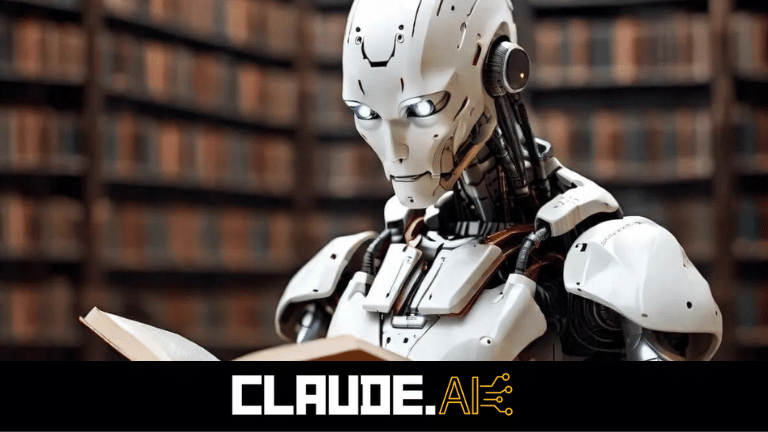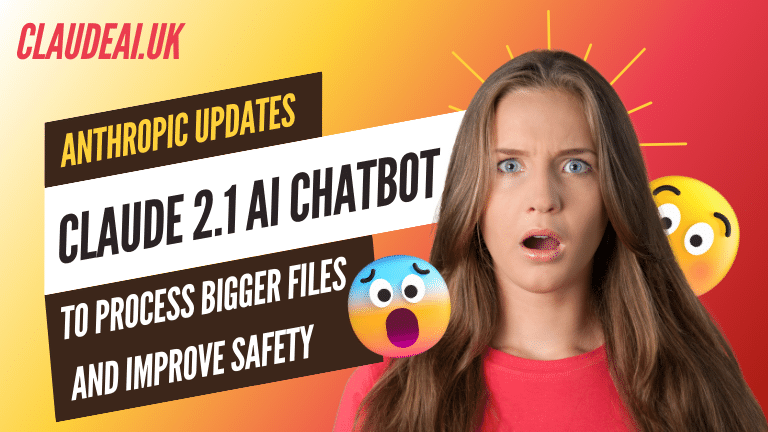Anthropic, the AI safety startup founded by Dario Amodei and Daniela Amodei, has released an update to its conversational AI assistant Claude. The update, Claude 2.1, focuses on enabling Claude to process larger file inputs while maintaining Anthropic’s rigorous safety standards.
Introduction
Anthropic was founded with the goal of developing AI systems that are helpful, harmless, and honest. The company’s first product, Claude, is focused on natural language conversations that assist humans.
Claude 2.1 builds on the existing capabilities of Claude 2.0 with a specific emphasis on improving Claude’s ability to handle larger file inputs. This allows Claude to process more data from users during conversations, opening up new possibilities for how Claude can be helpful.
At the same time, processing larger files also introduces new potential safety risks that Anthropic has worked to mitigate. I’ll discuss Anthropic’s approach to safety in more detail later in this article.
First, let’s look at the specific updates in Claude 2.1.
Claude 2.1 Updates
The Claude 2.1 update from Anthropic includes two main changes:
1. Increased File Size Limits
In Claude 2.0, there was a 100KB limit on the size of files that users could submit to Claude AI during a conversation. Claude 2.1 increases this limit to 10MB.
This means Claude can now process significantly larger file inputs like images, documents, and media files. Users can submit files up to 10MB to Claude to get assistance summarizing, describing, or answering questions about the contents.
Some examples of new use cases this unlocks include:
- Summarizing long reports or whitepapers
- Describing images in greater detail through computer vision
- Transcribing audio and video files
- Answering questions about larger datasets
The increased file size limit opens up many new ways Claude can interpret data and have more contextual conversations with users.
2. Asynchronous Support
Along with increased file sizes, Claude 2.1 also adds asynchronous support for long-running tasks.
Previously in Claude 2.0, all processing happened synchronously during an active conversation with a slowdown or delay for larger files.
Now in 2.1, Claude can process larger files asynchronously in the background without blocking the conversation. Users can submit a file, Claude will start processing it asynchronously, and the conversation continues.
Once processing is complete, Claude sends a notification that the results are ready. This improves the user experience for working with larger files.
Ensuring Ongoing Safety
While increased file size limits unlock new beneficial applications for Claude, it also introduces new potential risks around harmful or dangerous content.
As an AI assistant focused on being helpful, harmless, and honest, Anthropic takes safety extremely seriously in Claude. Every change and update goes through extensive internal testing and review focused on safety.
Here is an overview of Anthropic’s approach to ensuring Claude 2.1 remains safe despite the increased risks from larger file sizes:
Limited Access and Testing
First and foremost, Claude remains in limited access for internal users and trusted testers. Wider public access will only happen once rigorous safety standards are met in testing environments.
In addition, Anthropic deploys Claude 2.1 in a staged rollout to a small percentage of internal users initially. This allows the safety team to monitor real conversations and usage to catch any potential issues early.
Improved Content Moderation
Claude 2.1 updates also expand the content moderation capabilities to detect and filter inappropriate or dangerous content submitted via files.
This includes predictive censorship to flag textual content and computer vision algorithms to detect violent or explicit images. Detected content gets blocked automatically with safety notifications provided to users and engineers.
Ongoing work to improve moderation includes training algorithms on new types of problematic content and expanding to cover audio, video and other multimedia.
Conversation Safeguards
On the conversation side, Claude employs several safeguards to avoid responding inappropriately if users try to discuss or ask about dangerous topics related to file contents.
This includes topic whitelisting so Claude only entertains conversations related to productivity, entertainment, general information, and other safe topics.
There are also mechanisms to detect pivots in conversation towards unsafe topics and shut down the conversation politely if necessary rather than engage.
More Restricted Access
Finally, Claude’s capabilities for processing sensitive data will remain extremely limited even with larger file sizes. Things like personal emails or messages, financial documents, medical records and similar sensitive data should not be submitted to Claude.
Trying to discuss or process highly personal data will result in warnings, activity logs, and in extreme cases access revocation per Anthropic’s terms and conditions. Safety remains the top priority.
By combining all these approaches, Anthropic aims to allow Claude to handle larger file inputs to have richer conversations while limiting new risks thanks to rigorous safety standards.
Uses Cases Unlocked by Larger File Sizes
Now that we’ve covered the updates in Claude 2.1 and Anthropic’s approach to safety, let’s look at some promising new use cases enabled specifically by increased file size limits.
Here are a few examples of how users can take advantage of submitting bigger files to Claude within safe topics:
Summarizing Reports, Research Papers, and Long-Form Documents
Claude’s natural language processing capabilities make it adept at digesting long-form written content and summarizing key ideas and takeaways.
With the new 10MB file size limit, Claude can summarize entire reports, research papers, proposals, articles, long-form blog posts, and more to save users time.
Whether it’s condensing findings from a 100-page market research report or summarizing key takeaways from a new 50-page academic paper, Claude can reduce long documents down to salient summary.
This helps users quickly grasp core information without reading an entire document. It also helps identify which long documents are worth reading fully based on the quality of the summary.
Enhanced Image Description and Tagging
Similarly, Claude’s visual recognition capabilities are expanded by the new file limits.
Users can now submit high-resolution images up to 10MB in size like production photos, real estate listings, product images, and more for Claude to automatically describe, caption, and tag.
Rather than 1 sentence captions in previous versions, Claude can return full paragraph long descriptions along with relevant tags based on detecting objects, settings, emotions, colors and more in large images.
This tool can save media and marketing teams tons of time while optimizing images for accessibility. Market researchers can also submit large collages of product images to analyze similarities and differences.
Audio Transcription and Analysis
The file size bump now also enables users to submit audio files under 10MB like songs, podcasts episodes, speeches, or audio books for full automated transcription by Claude.
Beyond basic transcription, Claude can also return an analysis of the transcript summarizing topics discussed, highlighting key quotes, labeling speakers, and more.
For podcasts, Claude can identify topics covered to generate automated show notes. On speeches, Claude can pull out major talking points. This adds great value beyond raw transcription alone.
Dataset Analysis
Finally, data scientists and analysts can submit larger dataset files under 10MB to Claude for new forms of automatic analysis.
Examples include submitting a structured dataset for Claude to automatically highlight correlations, summarize distributions of variables, identify anomalies or outliers, and visualize interesting relationships in the data.
Claude can even take unstructured data like a folder of images, emails or documents and run clustering algorithms to automatically tag, group and highlight relationships across the varied data.
This enables hands-off dataset analysis even for non-technical domain experts.
Conclusion
Version 2.1 of Anthropic’s conversational AI assistant Claude opens up new possibilities for helpfulness by increasing file size limits that Claude can safely process. At the same time, Anthropic dedicates substantial resources to content moderation, conversation safeguards and rigorous testing procedures to ensure Claude meets strict safety standards regarding any problematic content submitted through larger files.
The result is an assistant that can have richer, more contextual conversations driven by large images, documents, datasets and media without compromising safety. Exciting new use cases enabled range from summarizing long reports and research to transcribing podcasts and describing images in great detail.
As Claude development continues, Anthropic plans to expand file support to new types while scaling content moderation and safety capabilities in tandem. Maintaining user trust through transparency and ethical AI design remains the top priority moving forward.
Anthropic welcomes any user feedback on Claude 2.1 capabilities for responsibly broadening the helpfulness of AI.

FAQs
What’s the main benefit of the Claude 2.1 update?
The main benefit is that Claude can now process files up to 10MB in size, enabling new use cases like summarizing long documents, describing high-resolution images, transcribing audio files, and analyzing datasets.
Does Claude 2.1 have any content restrictions?
Yes, Claude has strict content moderation policies and will block inappropriate, explicit, or dangerous files. Only submit content that aligns with Anthropic’s guidelines.
What file types does Claude support now?
As of version 2.1, Claude supports text documents, images, audio files, and structured datasets up to 10MB each. Support for additional file types is planned.
How does Claude summarize long documents?
Claude utilizes natural language processing models to identify key sentences, extract important topics, and synthesize the key ideas from long-form text.
What details can Claude provide when describing an image?
Based on computer vision algorithms, Claude can provide paragraph-long descriptions of images detailing objects, colors, emotions, estimated depth, and other visual attributes.
Can Claude replace expensive human transcription services?
For short, clear audio without background noise, Claude provides a free automated transcription alternative. Quality is not yet on par with human services for long or complex audio.
What analysis does Claude offer for datasets?
Claude can highlight correlations, outliers, cluster data into groups, summarize key trends, variables distributions and relationships for structured datasets up to 10MB in size.
Does Claude have access to any personal data I submit?
No, Claude exists solely to have the submitted conversation. Anthropic’s internal safety team reviews limited samples of conversations containing no user identities to ensure quality and safety.
Can Claude summarize sensitive documents like legal contracts or medical records?
No, Claude should only summarize publicly accessible documents aligned with Anthropic’s content guidelines, not private personal documents.
How accurate is Claude’s automated image description?
Accuracy varies greatly based on image complexity and type. Testing shows >90% accuracy for basic objects and scenes but lower accuracy for complex abstract images or those with many overlapping objects.
Can Claude help me cheat or provide answers during an exam?
No. Claude is designed specifically not to assist with cheating, exams, or any unethical acts.
What Claude capabilities raise the biggest safety concerns?
Summarizing extremist propaganda and describing graphically violent/explicit images have the highest potential harms. Multiple safety mitigations focus on these areas specifically.
Does Claude have any bias against marginalized groups?
Anthropic rigorously tests Claude for demographic biases and makes algorithmic adjustments to align with ethical standards, but no AI system is perfect. Users are encouraged to report any issues.
What happens if Claude processes inflammatory/dangerous content I submit?
Anthropic’s safety team is alerted, the account gets reviewed, monitored more closely for violations, and may face access limitations or termination.
Can I request new features to help Claude assist my unique needs?
Yes, Anthropic is actively soliciting feedback on new features that align with responsible AI development principles.

